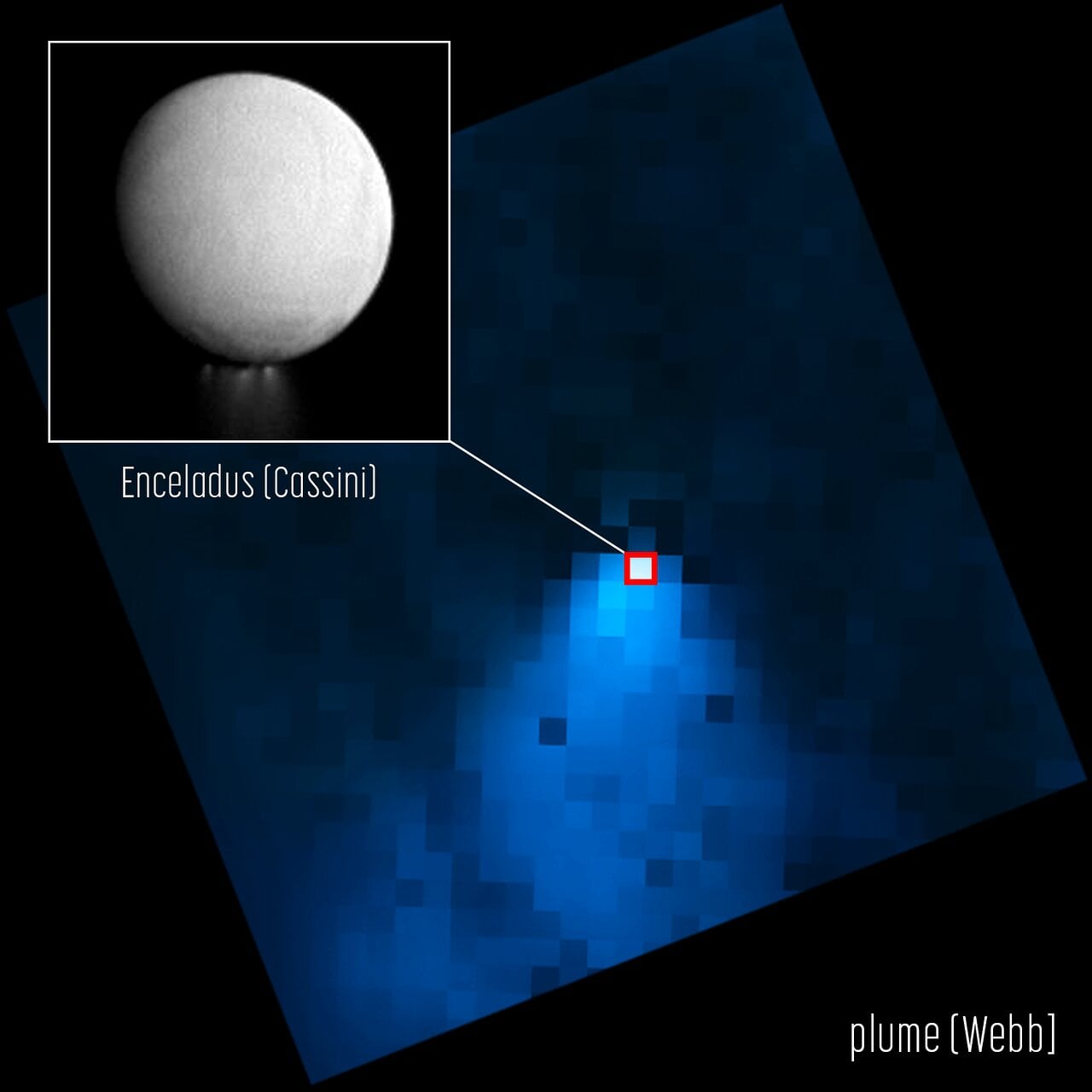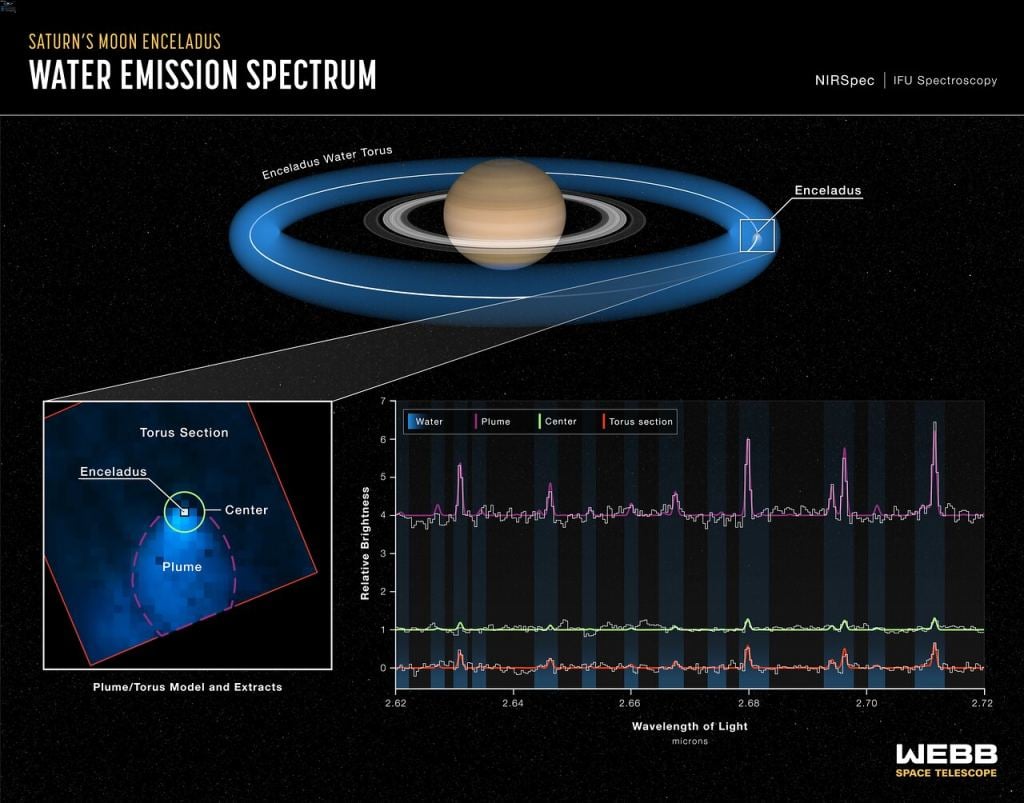The James Webb Space Telescope has observed a huge water vapor plume emanating from Saturn's moon Enceladus. Astronomers say the plume reaches nearly 10,000 kilometers (6,200 miles) into space, which is about the equivalent distance as going from Ireland to Japan. This is the largest plume ever detected at Enceladus.
Using the sensitive NIRSpec (Near-Infrared Spectrograph) instrument onboard JWST, the researchers were searching for organic compounds in order to characterize the composition and structure of the diffuse plumes. However, their observations revealed only emissions of water. But this giant plume was much larger than expected.
Enceladus itself is just 505 km (314 miles) across, meaning the plume is 40 times as big. We've known about the water plumes – which are fueled by a massive subsurface ocean -- since shortly after Cassini began studying Enceladus in 2005.
"These first observations with JWST (only a few minutes of integration time) demonstrate the power of this observatory for sensitively characterizing this ocean world, opening a new window into the exploration of Enceladus' ongoing plume activity while preparing for future missions," the team wrote in their preprint paper. The research team was led by Geronimo Villanueva from Goddard Space Flight Center and Heidi Hammel from the Association of Universities for Research in Astronomy (AURA). "More generally, JWST can provide detailed quantitative insights into H2O vapor-dominated geological and cryovolcanic activity elsewhere in the solar system."
Researchers using the NASA/ESA/CSA James Webb Space telescope recently discovered a plume jetting out from the south pole of Saturn’s moon Enceladus and extending more than 40 times the size of the moon itself. This animation illustrates how the moon’s water plumes feed the moon’s torus. By analysing the Webb data, astronomers have determined roughly 30 percent of the water stays within this torus, and the other 70 percent escapes to supply the rest of the Saturnian system of water. Credit:NASA, ESA, CSA, G. Villanueva (NASA’s Goddard Space Flight Center), A. Pagan (STScI), L. Hustak (STScI)On Twitter, Villanueva said it was "shocking" to detect a water plume that large.
The observed outgassing rate was at 300 liters a second, which could fill an Olympic-sized swimming pool in just a couple of hours. The researchers added that intriguingly, this outgassing rate is similar to the amount derived from closeup observations with Cassini 15 years ago. This suggests that the amount of eruption from Enceladus has been relatively stable over decadal timescales.
For such a tiny moon, Enceladus is incredibly intriguing. Its distance from the Sun means the moon should be a giant ice ball, but instead it is one of the most hydrothermally active places in our Solar System. Under its icy crust lies a global ocean of salty water and volcano-like jets spew water vapor from just under the moon's surface. Tidal heating from Saturn and other moons likely create an internal environment warm enough to host liquid water.
The team said that the uniqueness of JWST for exploring Enceladus was most evident when probing with unparalleled sensitivity the narrow infrared emissions emanating from the plume.
They searched for CO2, CO, CH4, C2H6 and CH3OH molecular emissions across the plume, but none were detected – just water vapor. However, the researchers were also able to observe directly how the moon's water vapor plumes feeds the water supply for the entire system of Saturn and its rings. A donut-shaped torus of water is located within Saturn's E-ring. The team said as Enceladus orbits rapidly around Saturn (with a period of only 1.37 Earth days), the ejected water vapor is spread along and around its orbit, forming the large water ring around Saturn.
By analyzing the data from JWST, the astronomers determined that roughly 30 percent of the water stays within this torus, and the other 70 percent escapes to supply the rest of the Saturnian system with water.
The JWST observations were part of the Solar System Guaranteed-Time-Observations (GTO) program, and were performed on November 9, 2022. The observations focused on Enceladus' trailing hemisphere.
The Cassini mission's observations revealed just how intriguing this moon is. In its first flyby, the spacecraft passed within 1,167 kilometers (725 miles) of the moon and a magnetometer detected a 'bending' of Saturn's magnetic field in the space above Enceladus, almost like it had an atmosphere. In subsequent flybys, Cassini found what appeared to be a surprisingly dense cloud of water vapor and ice grains over the south pole, as well as fissures and fractures on the surface, which were dubbed 'tiger stripes.' These fissures were found to be warmer than the rest of the moon, so clearly something was going on there. Enceladus was no dead little world. It was active.
ESA and NASA say that in the coming years Webb will serve as the primary tool for observing Enceladus, and discoveries from Webb will help inform future Solar System satellite missions that will look to explore the depth of the subsurface ocean, how thick the ice crust is, and more.
 Universe Today
Universe Today

